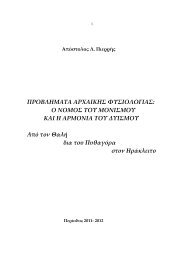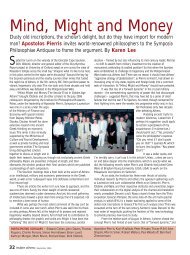chapter 10 the monism of darkness and the dualism of limit and ...
chapter 10 the monism of darkness and the dualism of limit and ...
chapter 10 the monism of darkness and the dualism of limit and ...
Create successful ePaper yourself
Turn your PDF publications into a flip-book with our unique Google optimized e-Paper software.
<strong>10</strong>2 CHAPTER <strong>10</strong><br />
angelic), psychic <strong>and</strong> earthly man (in all probability corresponding to <strong>the</strong><br />
distinction <strong>of</strong> <strong>the</strong> three Ophitic principles, lightspirit<strong>darkness</strong>), <strong>and</strong> <strong>the</strong>n<br />
devotes himself to an extended analysis <strong>of</strong> all Mysteries through<br />
emphatically erotic <strong>and</strong> venereal interpretations. It seems that Hippolytus<br />
<strong>of</strong>fers with <strong>the</strong> help <strong>of</strong> Ophitic texts <strong>the</strong> <strong>the</strong>oretical foundation <strong>of</strong> practices<br />
<strong>and</strong> rituals that Irenaeus mentions refusing to go intowhat he calls <strong>the</strong>ir<br />
unspeakable details. The Fa<strong>the</strong>rs <strong>of</strong> <strong>the</strong> Church agree that <strong>the</strong> sect in<br />
question was particularly multifarious with various subdivisions <strong>and</strong> that it<br />
was regarded as <strong>the</strong> Gnostic persuasion par excellence. The abominable<br />
Aeon <strong>and</strong> <strong>the</strong> Uterus <strong>of</strong> Nicolaites correspond to <strong>the</strong> Wind <strong>of</strong> Darkness =<br />
primogenitus Serpent <strong>and</strong> <strong>the</strong> Uterus <strong>of</strong> <strong>the</strong> Sethians. Undoubtedly, <strong>the</strong><br />
Ophitic, Nicolaitic <strong>and</strong> Sethian doctrines analysed above are related<br />
subgroups <strong>of</strong> this generic tendency.<br />
14. In <strong>the</strong> Phoenician <strong>the</strong>ologies according to Sanchouniathon <strong>and</strong> Mochus <strong>the</strong><br />
liquid nature <strong>of</strong> <strong>the</strong> second principle is not explicitly mentioned. However,<br />
Sanchouniathons Chaos is characterized as filthy <strong>and</strong> dark, whereas <strong>the</strong><br />
issue <strong>of</strong> <strong>the</strong> first copulation (named Mot) is described as slime or rottenness<br />
<strong>of</strong> aquatic mixture. The Spirit in intercourse with filthy wetness produces<br />
<strong>the</strong> first mudlike consistence, from which substance all determined <strong>and</strong><br />
delineated forms <strong>of</strong> existence, natural things, will crystallize into being by<br />
means <strong>of</strong> condensation. Ulomos-Un<strong>limit</strong>edness <strong>of</strong> Phoenicean cosmogony<br />
according to Mochus, must also be liquid, <strong>the</strong> Abyss <strong>of</strong> Waters, especially<br />
since by self-fertilization it engenders ChousorusAnoegeus (\AÓÔÈÁ‡˜ =<br />
Opener) <strong>and</strong> <strong>the</strong> cosmic Egg (FGrH 784 F4). Fertility was ascribed to <strong>the</strong><br />
liquid element as in Thales. It is worth noting that <strong>the</strong> Stoics interpreted<br />
Hesiodic Chaos as <strong>the</strong> wetness that existed prior to <strong>the</strong> world’s formation, v.<br />
Stoicorum Veterum Fragmenta I, No. <strong>10</strong>3-<strong>10</strong>5. II No. 437-564. Cf. II<br />
436. 565. In I <strong>10</strong>4 <strong>the</strong> cosmogonic <strong>the</strong>ory <strong>of</strong> Zeno (who came from Cition<br />
<strong>of</strong> Cyprus appleÔÏ›ÛÌ·ÙÔ˜ ^EÏÏËÓÈÎÔÜ ºÔ›ÓÈη˜ âappleÔ›ÎÔ˘˜ âÛ¯ËÎfiÙÔ˜,<br />
Diogenes Laertius VII, 1) is presented in mud-terminology: K·d Z‹ÓˆÓ Ùe<br />
apple·Ú’ ^HÛÈfi‰ˇˆ X¿Ô˜ ≈‰ˆÚ ÂrÓ·› ÊËÛÈÓ, Ôy Û˘ÓÈ˙¿ÓÔÓÙÔ˜ åÏfÓ ÁÂÓ¤Ûı·È, w˜<br />
appleËÁÓ˘Ì¤Ó˘ ì ÁÉ ÛÙÂÚÂÌÓÈÔÜÙ·È etc. The role <strong>of</strong> slime is central in <strong>the</strong><br />
Phoenician cosmogony according to Santhouniathon <strong>and</strong> in <strong>the</strong> Orphic<br />
cosmogony according to Hieronymus <strong>and</strong> Hellanicus. Otos <strong>of</strong> <strong>the</strong><br />
Sidonian <strong>the</strong>ology according to Eudemus is identical with Mot <strong>of</strong><br />
Sanchouniathon’s Cosmogony. The Mist <strong>of</strong> this Cosmogony (<strong>and</strong> <strong>the</strong><br />
corresponding un<strong>limit</strong>ed Chaos <strong>and</strong> foggy Erebos <strong>of</strong> Orphic <strong>the</strong>ology<br />
according to Hieronymus <strong>and</strong> Hellanicus) are meant to express liquidity in<br />
its airy form, that is to say <strong>the</strong> wetness <strong>of</strong> air or simply moist air.<br />
15. Classical Egyptian iconography represents <strong>the</strong> Ogdoad as frog-headed<br />
(male members) <strong>and</strong> snake-headed (female members). This is a reference to










